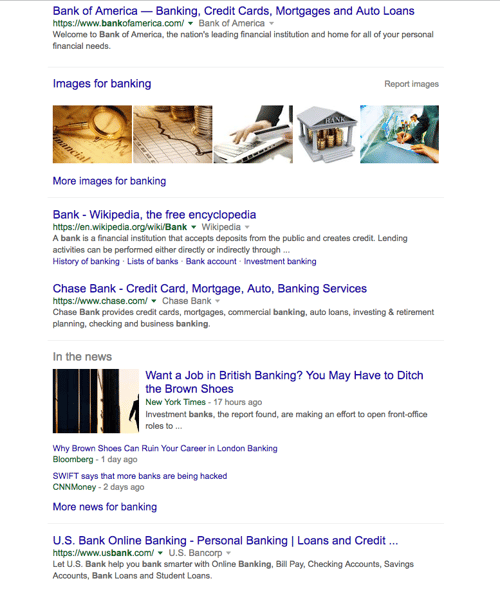If you work for a bank, how would offering a nominal short-term interest rate bump – or maybe a free toaster – increase website traffic?
The fact is that they wouldn't. These ideas stop way short of being smart, productive strategy. So what should you do?
 Professional bloggers and content marketing pros have learned that quality content geared toward a defined target audience is the single best way to generate more traffic on your website.
Professional bloggers and content marketing pros have learned that quality content geared toward a defined target audience is the single best way to generate more traffic on your website.
The fact is, though, just because you build it doesn’t mean anyone will come.
When you write quality business banking content with a defined audience persona in clear view while amplifying content in the places your audience appears, interested readers will follow. Predictably, reliably, and measurably.
Step One: Getting Your Headline Right Pays Off.
Truly ace writers devote lots of energy developing different headline options. In fact, the Content Marketing Institute has research across 150,000 web headlines and titles, and they found five best practices, each of which should increase your headline click-through rate.
For example, one of the tips is that length matters. They found the optimal length was eight words. Count the words in the title of this section. Trust me, it wasn’t an accident. A good way to learn to write better headlines is to practice constantly and hone your skills every time you write anything!
Expert bloggers typically start the headline development process by reading comments on sites where their prospects already congregate. Examples include forums, Facebook groups, and competitor sites already doing a good job leveraging social media.
Step Two: Match your Great Headlines with Different Types of Posts.
How-To: As the name suggests, these posts deliver information on how to do a given task or project. For example, in a banking environment, it might be a post about how to optimize use of your bank’s website. How-to posts are usually strong performers in organic search results.
Lists: Lists can take many forms. They might be practical, might be thought provoking, or might be simply entertaining. For example, "4 Ways Buyer Personas Can Grow Qualified Business Loan Leads." Whatever shape lists take, they’re search-friendly.
Thought Leadership: Have an idea that turns conventional industry wisdom on its head? Then write a thought leadership piece. As a bonus, this increases your chance of becoming a frequently quoted expert on your topic.
Newsjacks: What is newsjacking? Basically, it refers to capitalizing on a breaking news story to leverage it for sales or marketing purposes. You can co-opt timely content and raise site visibility by offering a fresh take on recent news. These examples will show you how it can be done.
Infographics: In this case, you’ll use a picture, or image, to tell your story in an interesting or useful way. Here’s a good banking example from the Wisconsin Bankers Association.
Step Three: Long-Tail Keywords are the Keys to the Search Kingdom.
While this may seem like strong promise, consider that, according to Google, about 70% of all search employs long-tail keywords. It’s an outgrowth of the emergence of natural language search. People instinctively use more detailed terms when searching for specific information.
Structurally, long-tail keywords consist of a head term paired with a long-tail keyword. The head term is more general, and leads to the targeted tail.
Let’s look at how this might apply in a bank setting:
- Search head term: banking
- Related long-tail search: business banking loans for small manufacturers
As an example, searching the generic term "banking" may get you results that include stuff like this:

It's not specific, and doesn't really help you with a problem. If you wanted truly useful information about business loans for small manufacturers, that’s not terribly helpful, is it?
Get Better Quality Web Traffic and Higher Conversion Rates
Long-tail keywords are specific, so visitors who make it to your website are the ones who are more closely qualified for what you can provide. Content targeting “small manufacturers seeking business loans” will get better quality web traffic than generic content resulting from a search for “banking.” Simply, when content is more relevant to the searcher, more search traffic will convert naturally into more qualified leads.

Long-tail keywords are inherently more specific. Think about it: everyone looking for a loan for his manufacturing business is looking for banks offering business loans, but not everyone looking for “banking” is doing the same. The more targeted you are, the fewer rivals to compete with, and the more interested prospects will be when they see content speaking directly to their needs. A term like "business loans for small manufacturers," may drive fewer overall searches than the broad term "banking." But, the visitors you attract will convert into leads at a much higher rate.
Once you determine your keywords, you can mold your online content around them. This is the heart of SEO – search engine optimization – the art of developing sites highly visible to searching users. To bring lucrative traffic your way, search engines have to understand what your site is about. Using well-chosen keywords throughout your site gives the search algorithms something to grab on to.
For example, if your term was business loans for small manufacturers, a low-competition keyword with high search volume, you could place it:
- In your page URLs
- In your page titles
- In your header tags
Good keyword strategies won’t close the sale on their own, though. Once prospects reach your site, you need to present beneficial content, appealing videos, well-designed graphics, and interesting offers to convery them to leads. Building an effective relationship with qualified prospects requires each content element to work together to reinforce your expertise and the validity of your offering.
How do you identify good keywords? Try using Google itself to show you related searches; it's a free solution. Or, you can use any of several other similar tools if you prefer. Then, you can move on to the next phase of the process.
Supercharge the Impact of Your Content – Amplify it with Social Media.

The incredible popularity and reach of social networks makes them perfect channels for you to pump up your message, usually at no out-of-pocket cost. Social is helpful whether you lead a team of business lenders, accountants, or anything else.
Content promotion is a helpful lever to increase your bank's blog traffic. To do it right, you have to invest your time and attention. Without follow-up after your original posts go live, you’ll fail to build excitement. That’s not good.
For example, there’s a basic problem with how most banks approach social media. They follow these steps:
- Create new content
- Share it on one social platform
- Forget about it
That’s not how it works. Social media is, first and foremost, participatory. It follows a crooked path. Social media users aren’t reading books. They’re at a party with hundreds of random conversations they can dip in and out of any time they want. Unless you work hard to be an interesting social media conversationalist, as it were, your messages are likely to be bypassed, ignored, or overlooked.
These are three better ideas for you to try:
- Share every blog post multiple times across several platforms
- Maintain consistency by sticking to a tight social sharing schedule
- Engage with others; use #hashtags, tag users, and talk directly to them; it is a conversation, after all.
Ultimately, the steps to better readership of your bank’s blog reduce to:
- Know your target audience in detail
- Generate useful content they’ll care about, and
- Share it widely and regularly
For more tips on how you can increase the return on your bank's content marketing or advertising investment, check out our Guide to B2B Inbound Marketing: Insider Secrets.





